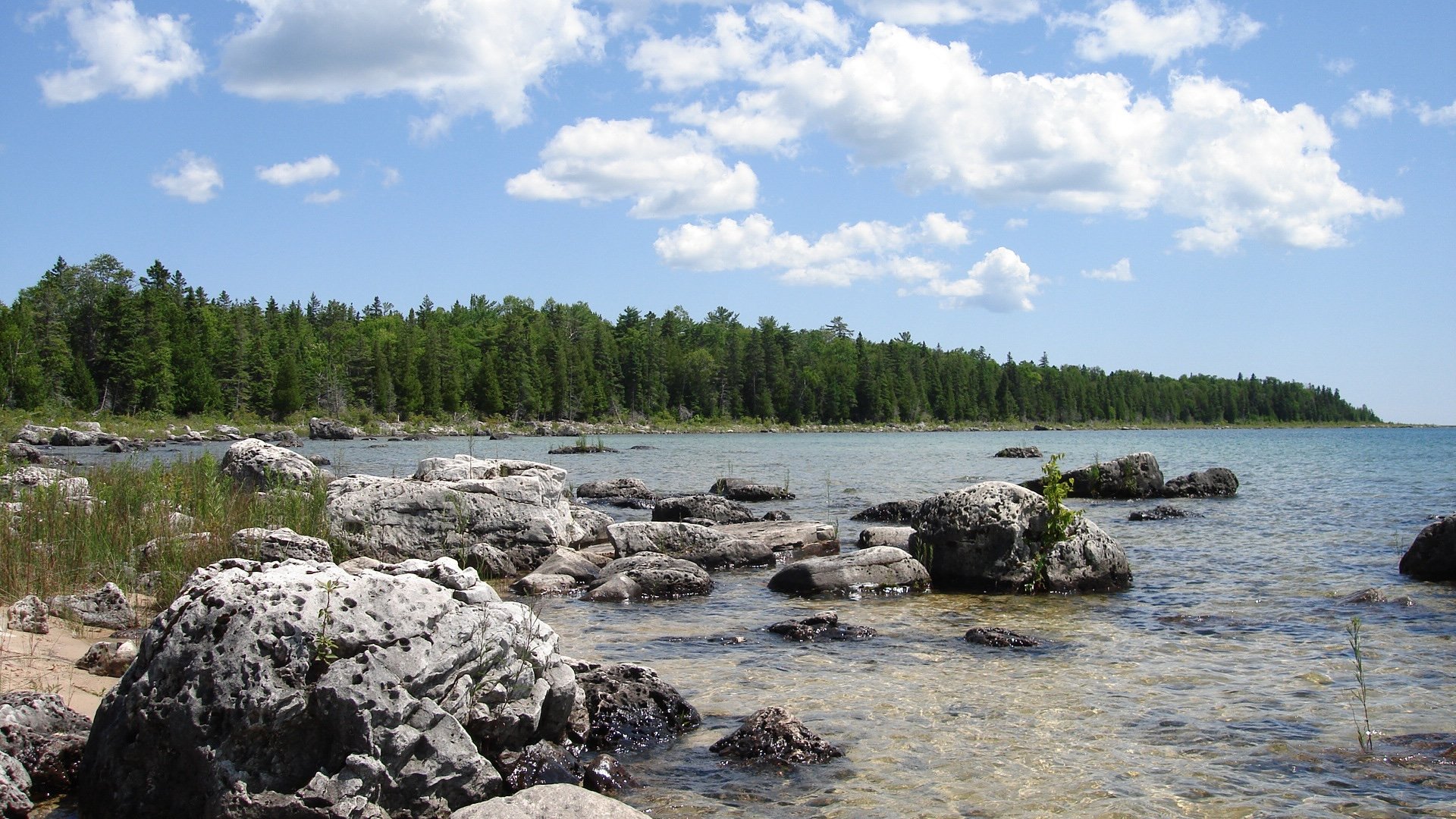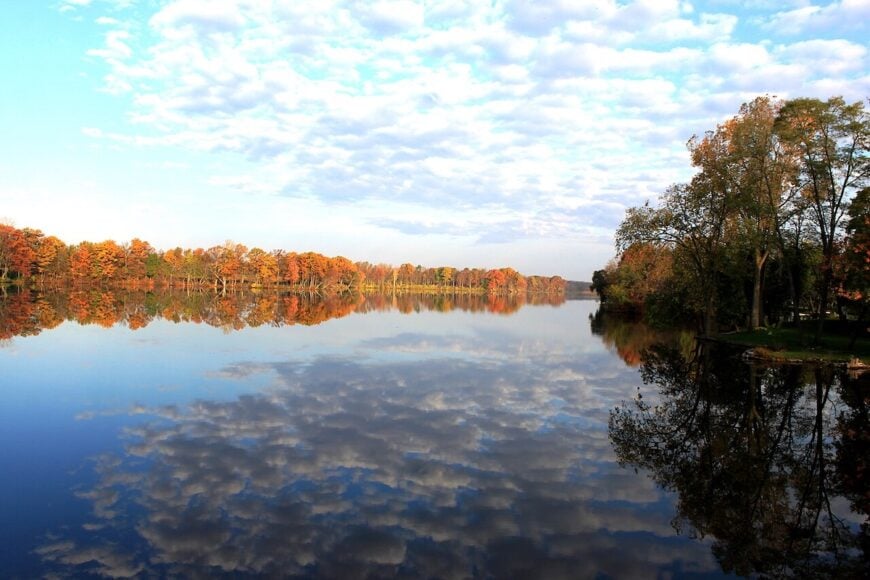
The surface image of Southeast Michigan is crowded freeways and commuter suburbs, yet just beyond that map lies a quieter ledger. Red Millpond in Tecumseh glints in the morning light, the River Raisin loops through fields and mill towns, and sandhill cranes call where the traffic noise falls away.
This is a region of working landscapes—grain bins standing taller than church spires, barns painted red against kettle lakes, and gravel lanes that collapse into shade as soon as the tree line thickens. The stillness is not empty but filled with small markers: a church bell, a ballgame on a summer night, or the creak of a dock on a millpond.
Our survey of 25 secluded towns begins here, in the overlooked spaces between Monroe’s corn rows, Lenawee’s Irish Hills, and Livingston’s state recreation lands. Each place holds a distinct rhythm, yet all share the habit of turning their back to the highway and facing instead toward rivers, creeks, and ridges.
Together they chart a Southeast Michigan that lives on a slower clock. The Raisin keeps flowing, Red Millpond keeps reflecting, and the backroads keep bending just enough to remind you that quiet is still part of the landscape.
25. London Township, Monroe County – Farmland Lanes Where Time Slows

Cornfields and fencerows define London Township, where only about 3,000 residents are spread across nearly 36 square miles. Days move at a gentle rhythm, marked by tractors crossing gravel roads and the steady hum of cicadas at dusk.
The township has no downtown proper, just a scattering of family farms, century-old churches, and a single fire station. Recreation means fishing along Swan Creek, stargazing from the middle of Grafton Road, or biking beneath wide skies that stretch to the horizon. Farming remains the backbone, with soybeans and corn rotating in steady cycles.
What makes London secluded is the absence of through-traffic—Detroit commuters take faster routes, leaving these lanes untouched. It’s the kind of place where silence feels like the main crop.
Where is London Township?

London Township sits in the far western edge of Monroe County, near the Washtenaw line, about 40 miles south of Detroit. It’s reached by county backroads branching from US-23 or M-50, but no highways cut directly through.
The drive brings you past barns and grain elevators before narrowing to dusty lanes. By the time you arrive, the world has already slowed down.
24. Maybee, Monroe County – A Village with More Chickens than Cars
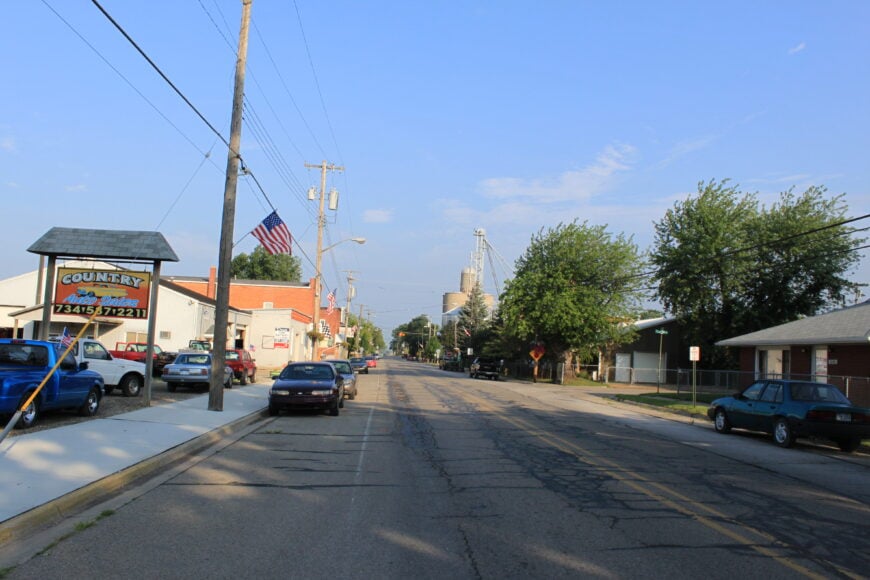
With fewer than 600 residents, Maybee feels like a living snapshot of early 1900s small-town Michigan. Old brick storefronts remain, now housing diners and antique shops, while backyard coops and vegetable gardens still line the alleys.
Locals gather for the annual Maybee Day festival, complete with tractor parades and homemade pies. The railroad that once fueled its growth is long quiet, leaving the streets to bicycles and the occasional hay wagon. Many residents still farm, though others commute to nearby Dundee or Monroe for work.
Its seclusion lies in being tucked between fields, far from interstates, with only two roads leading in or out. Maybee reminds you how good it feels when “busy” isn’t the default.
Where is Maybee?

The village lies about 15 miles northwest of Monroe, accessible from Dundee via Plank Road or from Milan via rural connectors. Highways like US-23 and I-75 loop far around it, ensuring the town stays calm.
Approaching, you pass stretches of bean and corn before suddenly arriving at a single stop sign and a row of brick façades. It feels more like stumbling on a memory than reaching a destination.
23. Deerfield, Lenawee County – Fields and Faith on the River Raisin

Deerfield has fewer than 1,000 residents, most of whom trace their family ties back generations. The River Raisin curls along the village edge, its banks lined with cottonwoods and the echoes of baseball games in summer.
Historic churches and tidy Victorian homes lend a timelessness, while the old grain elevator still stands watch beside the tracks. People fish, paddle, or walk shaded lanes where the loudest sound is often the church bell. The economy revolves around agriculture and a handful of small shops, with Ann Arbor commuters forming a quiet minority.
Its tucked-away feel comes from being miles off any major highway, where travelers rarely pass unless they mean to. Deerfield carries the stillness of a place where days are long remembered.
Where is Deerfield?
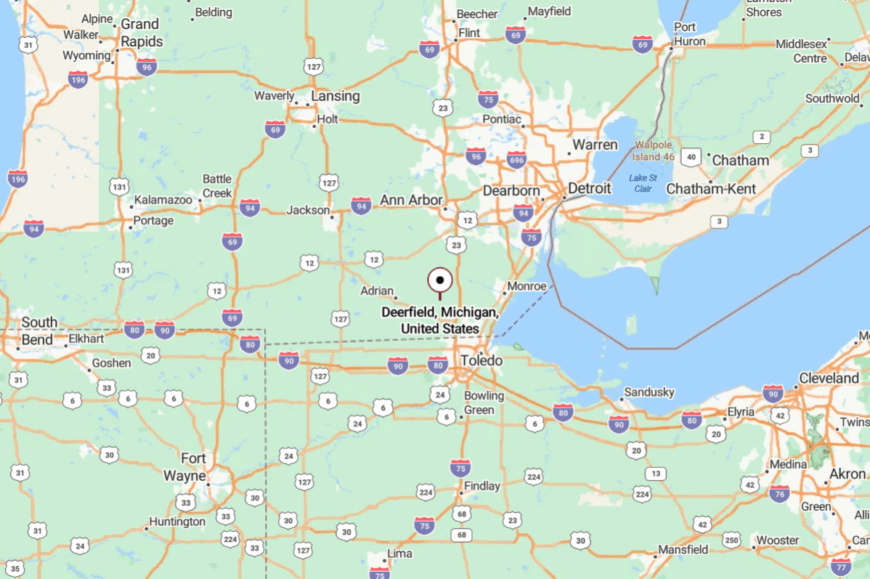
Deerfield sits in northeast Lenawee County, about 20 miles southeast of Ann Arbor. The village lies south of US-23 but isn’t connected directly to it, requiring turns onto state highways and then local lanes.
Reaching it feels like threading a maze of cornfields and creek valleys. When you arrive, the horizon seems to pause.
22. Petersburg, Monroe County – The Slow Heart of Bedrock Farms
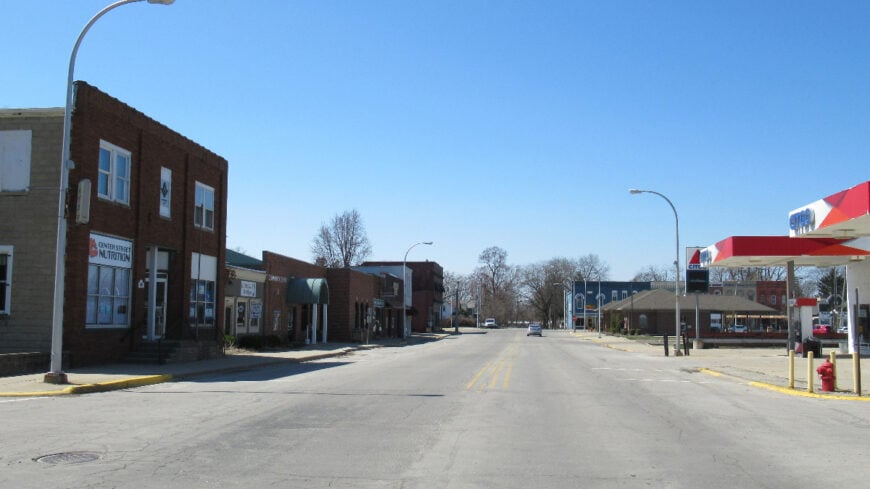
Petersburg, population just over 1,100, is a grid of tidy streets surrounded by unbroken farmland. Rows of soybeans and windbreak pines form the true walls of the town, cutting it off from the faster-paced outside world.
Locals pride themselves on the small-town rhythms: high school football games, pancake breakfasts at the fire hall, and evenings on the porch. The River Raisin Watershed runs nearby, offering canoeing and trout-fishing spots away from crowds.
A few industries exist—farm supply stores, seed operations—but most residents live in the steady current of agriculture. Its seclusion is its geography: flat farmland in every direction, with only two-lane roads feeding into it. Life here unfolds at the speed of a tractor.
Where is Petersburg?

Petersburg is tucked in western Monroe County, about 30 miles southwest of Detroit and north of the Ohio line. Travelers typically exit US-23 at Dundee and drive west on local farm roads.
With no expressways or truck routes, the town stays hushed even during harvest. The quiet sets in long before you reach Main Street.
21. Carleton, Monroe County – Railroad Echoes and Shady Porches
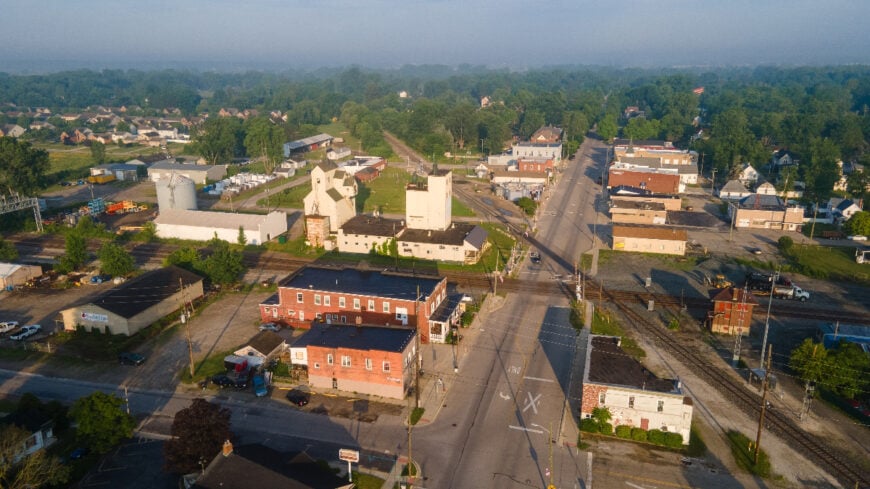
Carleton began as a railroad town, and though the trains still pass, the bustle long ago moved elsewhere. Today about 2,500 people live here, their homes shaded by old maples and wide front porches.
Residents gather at corner diners or for festivals at the local park, while kids fish the Huron River tributaries that wind nearby. Many commute north toward Detroit, but the town itself hasn’t changed much in decades.
Its seclusion comes not from distance but from being bypassed—the freeways cut around it, leaving Carleton in a kind of time pocket. Evenings here stretch long and golden, interrupted only by the faraway horn of a freight train.
Where is Carleton?

Carleton sits in northern Monroe County, about 25 miles south of Detroit. Though I-275 and I-75 run nearby, neither connects directly, forcing travelers to take local lanes.
The village feels hemmed in by farm fields and old rail lines that curve like boundaries. It’s close enough to the city, yet feels like it never quite joined it.
20. Onsted, Lenawee County – Gateway to the Hidden Irish Hills Lakes

With around 1,000 residents, Onsted is a place where people know each other by the sound of their truck engines. The village edges the Irish Hills, a rolling landscape dotted with hidden lakes and wooded ridges.
Locals fish Sand Lake, explore Hayes State Park, and kayak tiny channels where herons hunt. A handful of diners and hardware stores anchor Main Street, while farming and lake tourism sustain most livelihoods.
The town feels secluded because it is set back from highways, reached by two-lane roads that climb and dip like a rollercoaster through moraine hills. Summer brings a trickle of lake-cabin visitors, but winters return the hush. Onsted leaves you with the sense that water and woods outnumber people.
Where is Onsted?

The village is tucked into western Lenawee County, about 20 miles south of Jackson. Drivers exit US-223 or US-12, then meander through backroads hemmed by lakes and state land.
Getting there feels like entering a world of bends and hidden ponds. The journey itself whispers that you’re leaving ordinary routes behind.
19. Britton, Lenawee County – Grain Elevators and Gravel Quiet

Britton, with fewer than 600 residents, is the kind of place where a single blinking light marks the crossroads. A towering grain elevator dominates the skyline, symbolizing the farming backbone of the community.
Life here revolves around small diners, Little League games, and long walks along quiet lanes where fields roll to the horizon. The town has no major employers beyond agriculture, which adds to the quiet, timeless pace.
Seclusion comes from its placement—miles from interstates, buffered by miles of soybeans. A few cars pass each hour, usually belonging to neighbors. Britton is proof that the middle of nowhere has a heart.
Where is Britton?

The village sits in eastern Lenawee County, 12 miles east of Tecumseh and 30 miles southwest of Ann Arbor. US-23 skirts far to the west, leaving only local county roads to reach town.
Approaching, you see the elevator long before the houses. Once you arrive, there’s no mistaking that you’ve entered a place set apart.
18. Ida, Monroe County – A Parish Village Surrounded by Corn

Ida is best known for its red-brick Catholic church, whose spire rises above endless cornfields. About 4,000 residents live in the township, though the central village feels much smaller, with a gas station, diner, and ball fields.
Farming dominates—sweet corn festivals each August bring neighbors together in a celebration that feels like a county fair shrunk to village size. Quiet reigns most days, broken only by tractors or the church bell on Sunday.
Its seclusion comes from being far from highways, with farmland forming a natural moat in all directions. Many residents commute to Monroe or Toledo but return each night to a calmer pace. Ida feels like a town built on both soil and faith.
Where is Ida?

The village of Ida sits about 10 miles northwest of Monroe, off Lewis Avenue. It’s reached by country backroads branching from US-23 or M-50.
With no direct freeway access, the town stays hushed. By the time you arrive, the farmland has already pressed the world back.
17. Azalia, Monroe County – A Speck on the Map with Endless Sky

Azalia is less a town than a hamlet, marked by a handful of homes, a historic church, and the echo of trains on the old rail line. Fewer than 200 people call it home, making it one of the smallest communities in southeast Michigan.
The Raisin River flows nearby, drawing anglers and birdwatchers who savor the solitude. Fields and prairie grass surround the cluster of houses, leaving the horizon wide and the night skies dark.
Jobs are found elsewhere, but the few who live here prize the silence. Seclusion is absolute—blink and you might miss the turnoff. Azalia is the kind of place you find only when you’re not in a hurry.
Where is Azalia?

Azalia sits in northwest Monroe County, about 10 miles south of Ann Arbor. Travelers must leave US-23 at Milan and follow winding local lanes to find it.
The hamlet appears suddenly after miles of fields. It feels like a forgotten pause between places.
16. Clayton, Lenawee County – A Valley Town Kept by the Hills

Clayton, home to about 350 residents, rests in a shallow valley hugged by woods and farm ridges. The main street features only a handful of storefronts, yet the rhythm of life is steady: potluck suppers at the church, softball games on summer evenings, and cider pressed at roadside mills each fall.
Outdoor pursuits include exploring Iron Creek, hunting in nearby state game areas, and hiking rustic trails. Farming sustains most families, though a few commute into Adrian or Hudson.
Its seclusion lies in its remoteness—the nearest highway is miles away, and even cell signals fade among the ridges. Nights here are dark enough to hear only the hum of crickets and the occasional whip-poor-will. Clayton feels like it exists in its own season.
Where is Clayton?

Clayton sits in western Lenawee County, about 10 miles west of Adrian. It’s reached by rural lanes branching from M-34 or M-156, both narrow two-lane highways.
Hills and valleys shield it from the sprawl of larger towns. Arriving, you sense the land itself guarding its quiet.
15. Blissfield, Lenawee County – A River Village with Victorian Grace
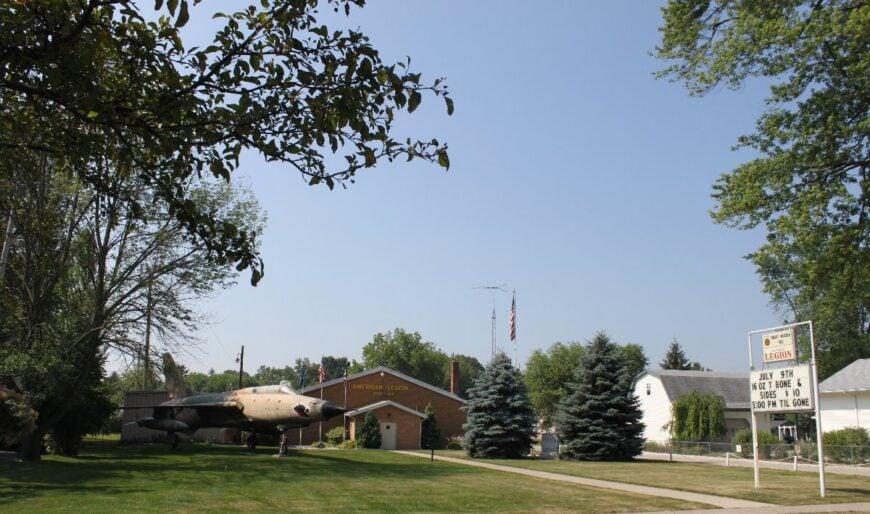
Blissfield, population 3,000, retains the grace of its Victorian downtown, with iron storefronts and historic homes shaded by ancient oaks. The River Raisin cuts through the center, creating riverside parks and trails that lend the village its calm.
Residents gather for antique tractor shows, county fair events, and fall color festivals that feel larger than the town itself. Seclusion comes not from being remote but from being bypassed—US-223 skirts around it, leaving downtown hushed and unhurried.
Farming and small industry provide the backbone, though antiques and tourism add flavor. On warm evenings, porch swings creak in rhythm with the river’s flow. Blissfield is the kind of place where time lingers.
Where is Blissfield?

The village is in eastern Lenawee County, about 25 miles southwest of Toledo and 20 miles east of Adrian. It’s reached by exiting US-223 and drifting into downtown via River Street.
Rail lines and the river hem in the village, reinforcing its sense of enclosure. Once there, you feel pleasantly removed from everything modern.
14. Clinton, Lenawee County – A Small Town Along the Macon Creek
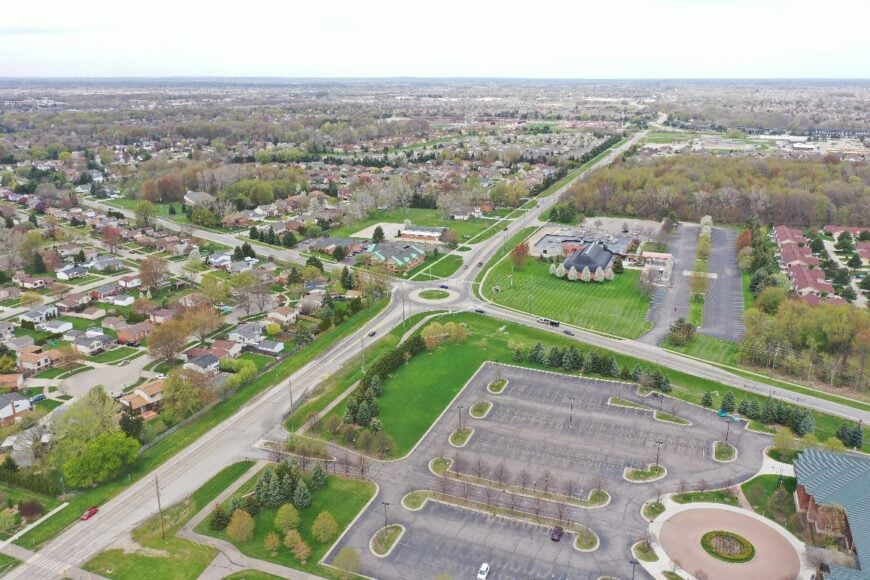
Clinton’s population of 2,300 belies the intimacy of its streets, lined with tidy homes, small shops, and a restored opera house. Macon Creek and nearby Tecumseh Woods offer kayaking, hiking, and birdwatching, while autumn brings harvest festivals to Main Street.
Many locals farm or run small trades, though proximity to Ann Arbor makes it a commuter village too. Its seclusion is in spirit: it feels far smaller than it is, wrapped in history and the steady rhythm of its fields.
Summer days hum with cicadas, autumn with football games, winter with woodsmoke. Clinton’s beauty lies in its simple consistency. It’s the kind of town that feels complete unto itself.
Where is Clinton?

The village sits in northeast Lenawee County, about 20 miles southwest of Ann Arbor. US-12 runs nearby, but the town remains tucked slightly south, keeping through-traffic away.
Visitors usually drift in on Clinton Road, a tree-lined two-lane that narrows at the river crossing. The town feels like a deliberate pause between bigger destinations.
13. Manchester, Washtenaw County – A Mill Village Wrapped in the River Raisin

Manchester, with 2,400 residents, retains its identity as a mill town, its historic dam and brick downtown echoing the past. The River Raisin winds through, creating waterfalls, fishing holes, and shaded riverside paths.
Annual chicken broils and Christmas festivals still bring the community together, with a spirit that feels deeply rooted. Small shops and a few light industries sustain the economy, but it’s the sense of enclosure—forests and hills ring the town—that maintains its hush.
Despite being within 30 miles of Ann Arbor, it feels like a world apart. Evenings here are defined by church bells and the sound of water rushing over stone. Manchester is a reminder that beauty lingers longest in the places less traveled.
Where is Manchester?

The village lies in southwestern Washtenaw County, about 25 miles from Ann Arbor. It’s reached via M-52, but the final miles wind through farmland and wooded ridges.
Arriving feels like stepping back in time as the river announces the town before you see it. The seclusion is as much emotional as geographic.
12. Webster Township, Washtenaw County – Glacial Ponds, Gravel Roads, and Night-Sky Quiet

Webster Township feels like the countryside hiding in plain sight—a quilt of hayfields, oak ridges, and small glacial ponds stitched together by slow gravel lanes. What keeps it secluded is the lack of a major highway slicing through; traffic peels off toward Ann Arbor or Brighton, leaving these backroads to tractors and bicyclists.
The vibe is gently rural and old-Michigan: historic farmsteads, red barns, and a township hall where community events still feel neighborly. Weekends mean paddling at Independence Lake County Park, strolling the trails at Fox Science Preserve, birding along the Huron River, or lingering over pie at a roadside market. Many residents farm or work remote jobs, while a handful of craft businesses operate from barn workshops set far back from the road.
After dark, porch lights are sparse and the sky opens wide enough to count constellations. It’s the kind of place where the day’s loudest moment might be a sandhill crane lifting from a wet meadow.
Where is Webster Township?

Tucked in the northwestern corner of Washtenaw County, Webster sits between Ann Arbor and Brighton yet feels a world apart. It’s about 10–15 miles from downtown Ann Arbor, reached via two-lane roads like North Territorial, Webster Church, and Mast that meander past fields and woodlots.
There’s no expressway exit dumping cars into its center, so you arrive gradually, as the pavement narrows and the hedgerows rise. Close enough for a quick drive, far enough to feel like you’ve left everything behind.
11. Dundee, Monroe County – A River Village with a Hidden Wild Side

Dundee, though larger at nearly 4,000 residents, still feels secluded thanks to the River Raisin curling through town and acres of surrounding farmland. Historic downtown buildings, many restored, host cafés, antique shops, and local museums, while the Cabela’s outpost on the edge draws outsiders who rarely linger past the freeway.
Locals kayak the river or cycle backroads that fade into silence within minutes. Farming remains an economic mainstay, with tourism adding a layer of bustle only briefly.
Despite being near US-23, Dundee feels buffered, as though the town holds its own pace separate from the highway. Evenings bring river breezes that hush the village into calm. Dundee is close, but somehow far away.
Where is Dundee?

The village sits in central Monroe County, about 20 miles north of the Ohio border and 25 miles south of Ann Arbor. It’s easily accessed from US-23, though the downtown sits tucked back from the freeway.
The River Raisin carves a natural boundary that separates the village from sprawl. Standing on its banks, you’d never guess how near the interstate hum really is.
10. Hell, Livingston County – A Forest-Ringed Hamlet Beyond the Tourist Sign

Hell claims fewer than 500 year-round residents, though summer weekends swell when sightseers pose beside the famous sign. Visitors quickly learn the real fun begins past the souvenir shop, where Pinckney State Recreation Area offers 40 miles of hiking and the calm backwaters of Bruin Lake for kayaking.
A small cluster of local businesses caters to day-trippers with ice cream, craft beer, and tube rentals, while many locals work in nearby Pinckney or commute to Brighton. Acre-plus wooded lots, sprawling wetlands, and the absence of any through-road beyond M-36 keep traffic low once the gift-shop crowd turns around.
Even cell service fades under dense oak canopies, adding a layer of digital hush. All told, Hell feels more like a deep-woods outpost than a novelty stop on the way to somewhere else.
Where is Hell?

The hamlet sits in southern Livingston County, roughly midway between Ann Arbor and Lansing. Thick state land to the west and the marshy floodplain of Portage Creek to the east form natural buffers that discourage subdivision growth.
Drivers reach town via M-36, then follow Dexter-Pinckney Road until pavement narrows to a shaded lane with no shoulder. Those who arrive by bike on the Lakelands Trail earn bragging rights along with an uninterrupted canopy of trees.
9. Lost Peninsula, Monroe County – Michigan’s Most Isolated Lake-Erie Sandbar

Only a few dozen permanent residents occupy this narrow finger of land that juts into Lake Erie, its population barely topping 150 outside boating season. Days revolve around the water: trolling for walleye, paddling the cattail channels of North Maumee Bay, and swapping stories at the Harbor View Yacht Club.
A pair of marinas and one dockside restaurant provide most jobs, while additional income comes from vacation rentals that vanish behind high reeds. What makes the peninsula secluded is geography; the only road briefly crosses into Ohio before looping back north, leaving the enclave cut off from the rest of Michigan by water.
Housing density sits well under 100 homes per square mile, and many cottages are reachable by boat as easily as by car. At night, the glow of Toledo shimmers across the bay yet feels worlds away.
Where is Lost Peninsula?

The sandbar occupies Monroe County’s extreme southeast corner, technically part of Erie Charter Township but surrounded on three sides by Lake Erie and the mouth of the Maumee River. Wetlands and open water act as a natural moat that limits both noise and development pressure.
Motorists must detour eight miles through Ohio on Summit Street before re-entering Michigan via Edgewater Drive. This quirk delights residents who enjoy telling first-timers to bring two state maps. Boaters skip the asphalt entirely by tying up at the fuel dock and walking home.
8. Gregory, Livingston County – Rolling Pastures at the Edge of Waterloo Recreation Area

Gregory’s census count hovers near 250, yet its social calendar stays lively thanks to nearby horse shows and the famed DTE Energy mountain-bike trails.
Waterloo Recreation Area, Chain-of-Lakes paddling, and the Waterloo-Pinckney Hiking Trail tempt outdoor fans, while the local feed store doubles as a coffee stop where riders trade trail conditions.
Small-scale cattle operations and equestrian boarding barns provide primary employment, supplemented by telecommuters drawn to reliable fiber internet recently strung along M-106.
Seclusion stems from 20,000 acres of surrounding state forest that swallows noise and light before either can reach the village crossroads. The night sky remains so dark that the Milky Way paints a clear stripe above hayfields each summer.
Even GPS can be unreliable on the township’s maze of gravel, ensuring lost tourists give up long before they reach the quiet heart of town.
Where is Gregory?

This crossroads community lies 17 miles northwest of Ann Arbor, tucked against the western edge of Washtenaw County yet officially within Livingston. Thick oak-hickory stands and kettle-hole wetlands hem the road network, keeping new cul-de-sacs at bay.
The simplest approach follows M-106 from Stockbridge, then ducks south on Unadilla Road until the pavement ends at Main Street’s lone flashing light. Cyclists often roll in from Chelsea along the 13-mile Mike Levine Lakelands Trail, greeting sandhill cranes en route.
7. Goodland Township, Lapeer County – Wide-Open Prairie Meets Quiet Woodlots

Roughly 1,800 people share the township’s 36 square miles, translating to fewer than 50 neighbors per square mile. Weekend fun ranges from stargazing parties at the community park to snowmobile runs across bean stubble when January drifts pile high.
Agriculture drives the local economy, with corn dryers humming at dusk and a few specialty maple syrup operations tapping roadside groves each March. One-acre minimum lot sizes, a total absence of stoplights, and section roads laid out on the mile grid preserve a hush that feels much farther than an hour from Detroit.
The prairie-like openness allows sunsets to stretch in all directions, interrupted only by a lone silo or windmill. Night drivers often stop their engines midway down Bowers Road just to appreciate the stillness.
Where is Goodland Township?

The township sits due east of Lapeer and south of I-69, yet no interstate interchange spills traffic onto its roads. Slightly rolling ground rises to a modest moraine ridge, forming a visual barrier that hides subdivision lights from neighboring counties.
Most visitors exit the freeway at M-53 and drift west along gravel spurs that pass dairy barns and vintage schoolhouses. Arrive after dark, and the glow of Orion’s Belt will guide the final miles better than any streetlamp.
6. Ruby, Clyde Township – Hidden Pines off the Two-Lane Blacktop

Ruby began as a sawmill stop in the 1870s and now counts perhaps 500 scattered residents beneath thick white-pine canopies. Locals hunt whitetail in state forest parcels, paddle the Black River, and browse quirky antiques at the old depot on Wildcat Road.
A handful of tree-service outfits and small-plot farms anchor employment, though many residents enjoy short commutes to Port Huron’s hospitals and paper mills. What seals Ruby’s privacy is geography: gravel lanes dip into hillocks then climb into pines, muffling every passing vehicle long before it reaches the next bend.
State-protected forest hems three sides, while the remaining quadrant faces only hayfields and a single-phase power line. Even on holiday weekends, a five-minute pause at the four-way stop can yield no other cars.
Where is Ruby?

The settlement sits 15 miles west of Port Huron in northern Clyde Township, St. Clair County. Paved Beard Road narrows to packed gravel, forcing visitors to ease below 35 mph as they wind through timber.
Seclusion grows as cell reception fades, courtesy of the surrounding basin that sits just low enough to block nearby towers. Those who follow the historic rail grade northward can still spot iron spikes embedded in cedar ties beside the trail.
5. Sharon Township, Washtenaw County – Historic Farm Lanes Between Chelsea and Manchester

About 650 residents call Sharon Township home, many tracing family roots back to the 1840s when the first German immigrants raised barns along Bethel Church Road. Recreation centers on River Raisin kayaking, birdwatching in mature oak groves, and summertime pie socials at the restored township hall.
Agriculture remains the leading trade, with soybeans, heritage wheat, and pasture-raised beef keeping silos full, while a few artists run studio barns that open during the annual River Raisin Art Tour.
The area’s buffer of conserved land and century-old hedgerows blocks both sight and sound from U-M football traffic only 20 minutes north.
Night skies reveal Perseid meteors unspoiled by stadium glare, and gravel lanes still carry more tractors than sedans. That combination of heritage and hush defines Sharon’s enduring appeal.
Where is Sharon?

The township sits southwest of Ann Arbor, wedged between Chelsea, Manchester, and the River Raisin lowlands. Rolling moraine ribs and the River Raisin valley leave no obvious corridor for large roads, so only two-lane M-52 brushes the eastern edge.
Drivers coming from I-94 weave south on the narrower country roads before the route pinches to a single-lane bridge that naturally slows traffic. Cyclists prefer Schneider Road, a ribbon of pavement shaded by maples whose branches meet overhead like a tunnel.
4. White Oak Township, Ingham County – Oak Barrens and State Game Land Seclusion

Just over 1,100 residents share this square of rural Ingham County, where oaks emerge from sandy soil known as the White Oak Barrens. Outdoor life revolves around the state game area: wild-turkey calling contests, ice-fishing on tiny Cedar Lake, and springtime hikes among prairie smoke wildflowers.
The few storefronts include a feed mill and a century-old general store, with additional income drawn from row-crop fields and remote work that rides surprisingly strong fiber lines installed for nearby schools.
Seclusion thrives thanks to strict five-acre zoning and a high water table that discourages dense septic development, leaving homes tucked far back from sinuous roads.
Nighttime delivers coyote yips rather than highway hum, and porch lights remain scarce enough for fireflies to take center stage. Even the UPS driver keeps field glasses on the dash for midday sandhill-crane flyovers.
Where is White Oak?

The township lies 20 minutes south of Williamston and the I-96 corridor, yet feels much farther once one turns off M-52 onto Lovejoy Road. State game parcels flank the western edge, while the Red Cedar River snakes through cedar swamps to the east, both acting as natural walls against sprawl.
Visitors coming from Lansing usually exit at Webberville and follow Grand River Avenue until asphalt gives way to dust and the smell of sweet fern. Winter travelers should watch for drifting snow that often piles waist-high across Noble Road’s open flats.
3. Northern Addison Township, Oakland County – The Hidden Lakes District

Roughly 2,500 residents live in the forested northern half of Addison Township, where glacial kettle lakes outnumber stop signs. Daily recreation includes paddling crystal-clear Buhl Lake, hiking the 20 miles of trails at Addison Oaks County Park, and ice-skating informal rinks once winter sets in.
Local employment centers on small orchards, hobby farms, and weekend tourism tied to lake-house rentals, with many full-timers working remotely while loons call outside. Nature enforces seclusion through wooded ridges that block cell towers and the irregular shape of private lakes that prevent long straight roads.
Most parcels exceed three acres, and dense tree cover hides rooftops even from the air. Sunrise mist lifting off the water often muffles any human sound entirely.
Where is Northern Addison Township?

The northern half of Addison Township sits in north-central Oakland County, just below the Lapeer County line. It’s roughly 15 miles from the nearest expressway interchange, making it one of the county’s harder-to-reach corners.
Steep glacial ridges and winding lake basins force roads like Hosner and Lake George into narrow, curving paths that discourage shortcut traffic. Visitors often exit I-75 at Baldwin Road and meander northwest through farm fields before the woods suddenly close in.
2. Bridgewater Township, Washtenaw County – Soybean Horizons and Gravel Byways

Bridgewater’s 1,700 residents wake to sunrise over soybeans and the distant whir of grain elevators along Austin Road. Entertainment runs to gravel-road cycling loops, seasonal corn mazes at Alber Orchard, and evening walks beside century-old stone fences left by early Irish farmers.
Agriculture dominates the economy, but a small cluster of artisan cheese makers and hop growers adds flavor to the landscape. Seclusion is maintained through sweeping farm vistas devoid of commercial strips, plus a population density under 50 people per square mile, only 45 minutes from downtown Detroit.
Locals still gather at the 1876 township hall for potlucks, where dishes travel farther than most daily commutes. The broad sky and open land create views that stretch clear to the purple line of the Irish Hills.
Where is Bridgewater Township?

Placed west of Saline and east of Clinton, the township straddles the headwaters of the River Raisin. No major highways cut through; instead, Austin and Bethel Church Roads provide the main arteries, both narrow enough that combines take the full lane during harvest.
Travelers from US-23 exit at Willis Road, then drift south into a patchwork of fields where GPS directions often lose satellite lock. The absence of bright signage means the first hint you have arrived is a green metal bridge over a quiet creek.
1. Marathon Township, Lapeer County – Hill Country North of the Holloway Reservoir

Marathon Township’s population stands just above 4,600, yet homes scatter widely among rolling moraine hills and maple stands that burn scarlet each October.
Residents kayak the secluded coves of Holloway Reservoir, hunt mushrooms in forgotten orchards, and join neighbors for Friday fish fries at the 1920s Grange Hall on Farrand Road.
Local jobs revolve around row-crop farming, seasonal tourism tied to the reservoir, and a handful of home-based craft businesses that ship maple-syrup candies nationwide.
Privacy comes naturally thanks to undulating terrain that hides houses behind ridges, multi-acre zoning that sets long driveways, and the lack of any state highway within township limits.
Even mailboxes sit in clusters along the main blacktop so carriers can avoid threading every winding spur. The result is a countryside where silence is broken only by the startle of a whitetail bounding across a meadow.
Where is Marathon?

The township lies directly north of the Holloway Reservoir and southwest of Davison, bordered by the Flint River to the south. Hills and thick maple groves force roads like Marathon and Bullock to follow serpentine routes that naturally slow outsiders.
Drivers usually exit I-69 at Elba Road, then head north, where pavement soon turns to patched chip-seal and the tree canopy closes overhead. Those arriving by boat can motor west from the public launch at Zemmer Park, following the shoreline until songbirds drown out the distant hum of outboards.



